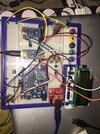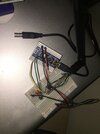Nothing to do with Tesla, but as some folk here seem to be into Home Automation and the like I thought I would ask.
I want to know what the temperature is in my greenhouse ... so that when I forget to open it I get an alert (and some other temperature scenarios I either want to alert, or just record).
(Automatic openers, such as expanding-wax, aren't suitable)
I'd like outside temperature and greenhouse temperature (soil temperature would be nice too, but that changes so slowly that a soil thermometer manually recorded once a week is probably fine ... albeit rather old-school)
Greenhouse is a decent distance from the house and line-of-sight obscured by a thick, tall, hedge. I'm doubtful that WiFi would work ... but it might.
I have power in the greenhouse (maybe ethernet-over-power-cable would work, house wiring is complicated, so the greenhouse circuit might not be shared such I could usefully locate the house-end Ethernet adaptor - I probably should try that though).
I want to log the data to my PC, not to a Cloud service that I have to pay for (and/or a recurring cost for the mobile-connector thingie), but tell me if I'm daft and that IS the solution
I've looked at Weather Stations - they often have an Indoor and Outdoor temperature probes. Can find one that is sophisticated and provides logging, but doesn't use mobile connection. There are brands suitable for a "DIY" route where all components are individually sourced, but requires a fair amount of work to build and program etc. I have the skill but not the time, so would much prefer a plug-and-play solution. So DIY which needs more than an hour or two of effort is my last resort.
I want to know what the temperature is in my greenhouse ... so that when I forget to open it I get an alert (and some other temperature scenarios I either want to alert, or just record).
(Automatic openers, such as expanding-wax, aren't suitable)
I'd like outside temperature and greenhouse temperature (soil temperature would be nice too, but that changes so slowly that a soil thermometer manually recorded once a week is probably fine ... albeit rather old-school)
Greenhouse is a decent distance from the house and line-of-sight obscured by a thick, tall, hedge. I'm doubtful that WiFi would work ... but it might.
I have power in the greenhouse (maybe ethernet-over-power-cable would work, house wiring is complicated, so the greenhouse circuit might not be shared such I could usefully locate the house-end Ethernet adaptor - I probably should try that though).
I want to log the data to my PC, not to a Cloud service that I have to pay for (and/or a recurring cost for the mobile-connector thingie), but tell me if I'm daft and that IS the solution
I've looked at Weather Stations - they often have an Indoor and Outdoor temperature probes. Can find one that is sophisticated and provides logging, but doesn't use mobile connection. There are brands suitable for a "DIY" route where all components are individually sourced, but requires a fair amount of work to build and program etc. I have the skill but not the time, so would much prefer a plug-and-play solution. So DIY which needs more than an hour or two of effort is my last resort.





